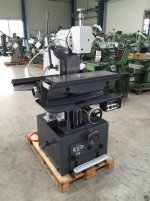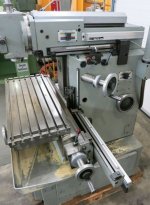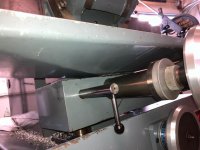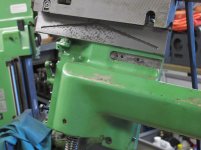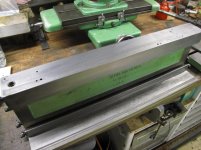rklopp
Diamond
- Joined
- Feb 27, 2001
- Location
- Redwood City, CA USA
I received the following PM from a member who can announce himself if he chooses. I feel the conversation should be public so it can help all of the other millions of Aciera F5 owners in the world  .
.
"Hello Rich, as an owner of a F5 I have a question for you.
I am thinking of buying a late F5 (dc axis motor) and was wondering is there any way of mounting the X axis DRO scale under the table. I don't like the current side mounting as it sticks out the side of the machine way too much.
I know you can remove the X axis ruler assembly which would be my first job but re-fitting the scale may be a problem with the coolant tray directly below the table.
Having never actually seen an F5 I thought you may be able to help. Also any good tips to look out for would be helpful.
Many thanks"
My machine came with tapped holes in the lower corners of the "apron," and the tray detached. I think some prior owner had mounted an X-scale there, without the tray. The reader head appears to have been mounted on the face of the saddle at a place that would have been totally blocked by the chip tray. The red ovals in the photo below explain the situation. There were also tapped holes for what must have been a Y scale. I don't see any signs of a Z scale mounting, and whatever DRO was present was gone by the time I got the machine. I put on the chip tray, which came detached and may have been from another machine, and plugged the tapped holes with setscrews. I believe my machine is a late 1960s first generation F5, which has an identical apron and chip tray as my late 1970s F4.
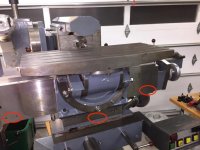
There does not appear to be enough room under the chip tray for an X scale when the Z is lowered to the bottom. In addition, I don't see an easy way to anchor the X scale to the apron and have the anchors poke through the chip tray. I supposed you could try to mount the X scale on the chip tray itself, but that seems like a terrible idea from a precision standpoint. Every single F4 or F5 X scale installation I have seen has mounted the scale on the trip dog spar for the X axis, and I have looked at dozens in photos. That is how I plan to mount mine when I get around to it. That is how the scale is mounted on my F4. In that case, the ruler function is gone, but the trip dogs are still functional. The left trip dog had surgery to clear the scale reader head cable, but it is still functional. The scale is fully contained within the length of the spar, so there is no more stick-out than the spar itself. I plan to keep both the ruler and trip dogs functional on my F5. Besides liking the trip dogs and scale, I will not remove the spar, because is has a lube Zerk fitting on it and helps to seal the place where the X feed screw and power feed shaft exit the saddle.
Here is a photo of a machine that I believe could be my machine's twin brother, as it shares some of the same tappings (including the end of the spar, which suggests my machine had a different DRO X axis installed at some point). The only difference is that my machine lacks the hand lever quill feed. Notably, the brother machine also is missing the chip tray. Both machines are Canadian.
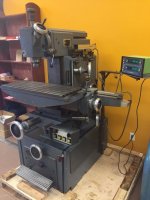
The following photo gives some idea how difficult it would be to mount the scale below the chip tray and have it anchored to the apron.
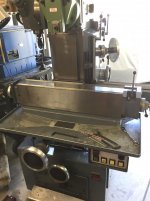
I would google "Aciera F5" images, and see what others have done, and pick what you like.
 .
."Hello Rich, as an owner of a F5 I have a question for you.
I am thinking of buying a late F5 (dc axis motor) and was wondering is there any way of mounting the X axis DRO scale under the table. I don't like the current side mounting as it sticks out the side of the machine way too much.
I know you can remove the X axis ruler assembly which would be my first job but re-fitting the scale may be a problem with the coolant tray directly below the table.
Having never actually seen an F5 I thought you may be able to help. Also any good tips to look out for would be helpful.
Many thanks"
My machine came with tapped holes in the lower corners of the "apron," and the tray detached. I think some prior owner had mounted an X-scale there, without the tray. The reader head appears to have been mounted on the face of the saddle at a place that would have been totally blocked by the chip tray. The red ovals in the photo below explain the situation. There were also tapped holes for what must have been a Y scale. I don't see any signs of a Z scale mounting, and whatever DRO was present was gone by the time I got the machine. I put on the chip tray, which came detached and may have been from another machine, and plugged the tapped holes with setscrews. I believe my machine is a late 1960s first generation F5, which has an identical apron and chip tray as my late 1970s F4.

There does not appear to be enough room under the chip tray for an X scale when the Z is lowered to the bottom. In addition, I don't see an easy way to anchor the X scale to the apron and have the anchors poke through the chip tray. I supposed you could try to mount the X scale on the chip tray itself, but that seems like a terrible idea from a precision standpoint. Every single F4 or F5 X scale installation I have seen has mounted the scale on the trip dog spar for the X axis, and I have looked at dozens in photos. That is how I plan to mount mine when I get around to it. That is how the scale is mounted on my F4. In that case, the ruler function is gone, but the trip dogs are still functional. The left trip dog had surgery to clear the scale reader head cable, but it is still functional. The scale is fully contained within the length of the spar, so there is no more stick-out than the spar itself. I plan to keep both the ruler and trip dogs functional on my F5. Besides liking the trip dogs and scale, I will not remove the spar, because is has a lube Zerk fitting on it and helps to seal the place where the X feed screw and power feed shaft exit the saddle.
Here is a photo of a machine that I believe could be my machine's twin brother, as it shares some of the same tappings (including the end of the spar, which suggests my machine had a different DRO X axis installed at some point). The only difference is that my machine lacks the hand lever quill feed. Notably, the brother machine also is missing the chip tray. Both machines are Canadian.

The following photo gives some idea how difficult it would be to mount the scale below the chip tray and have it anchored to the apron.

I would google "Aciera F5" images, and see what others have done, and pick what you like.



